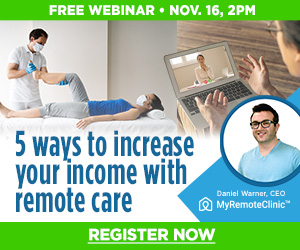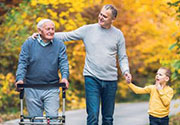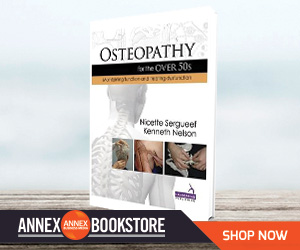| |
| |
 |
 |
| |
 |
|
@{mv_date_MMM d, yyyy}@ |
|
| |
» Read more...
» Read more...
» Read more...
|
| |
|
| |

Today, many healthcare practitioners are concerned about the future of their business. If you’ve faced reduced clinic hours, losing control of your own schedule, or want to shift your practice to at-home or online care, don’t miss out on our next webinar, presented by My Remote Clinic.
Build your client roster, generate a consistent revenue stream, and identify and overcome remote care challenges.
Our free webinar is LIVE Nov 16 at 2 p.m. Join us at the link below, and don’t forget to submit your questions on the registration form!
>> Register Now |
| |
|
| |
 One very important aspect of the aging process is that all muscles begin to weaken, more specifically in the lower body. Muscle mass and strength/power declines. This contributes to the aging person becoming more unstable, predisposing them to falls. They begin to alter their gait patterns and their stride length shortens until it becomes a shuffle. These aging changes contribute to numerous body and functional changes for the aging person. To better appreciate some of the contributing factors, we will briefly look at their muscle activity levels, diet and exercise, which will provide insights into the progression and their impairment and how we may begin to reverse some of these impairments.
» Read more...
One very important aspect of the aging process is that all muscles begin to weaken, more specifically in the lower body. Muscle mass and strength/power declines. This contributes to the aging person becoming more unstable, predisposing them to falls. They begin to alter their gait patterns and their stride length shortens until it becomes a shuffle. These aging changes contribute to numerous body and functional changes for the aging person. To better appreciate some of the contributing factors, we will briefly look at their muscle activity levels, diet and exercise, which will provide insights into the progression and their impairment and how we may begin to reverse some of these impairments.
» Read more... |
| |
|
| |

Although textbooks on the subject of Osteopathy have been in print for over 100 years, there is little material specifically addressing the treatment of adults over the age of 50, in spite of the increase in this demographic group.
This book is intended to provide a study of the biomechanics and physiology of somatic dysfunction as it relates to individuals over the age of 50.
>> Order now |
| |
|
| |
|
|
| |
| |





